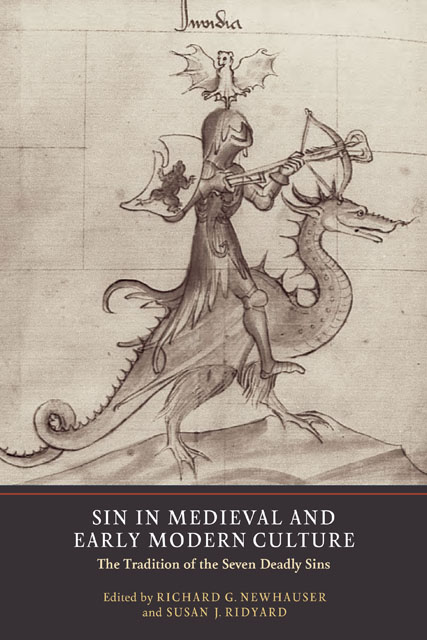5 - A Fifteenth-Century Sermon Enacts the Seven Deadly Sins
Published online by Cambridge University Press: 28 February 2023
Summary
The doctrine that Christ bore the sins of the world when he suffered on Good Friday finds tangible form during the late Middle Ages in a topos that connects each of the seven deadly sins with one of Christ’s torments. The sermon examined here makes this topos its framework and elaborates upon it by connecting each deadly sin to another heptad: seven diseases that Christ miraculously cured. The symptoms of these diseases are in turn likened to events of the Passion: Christ suffered the symptoms of those who suffer from the diseases in order to cure the sins to which the diseases are linked. The sermon’s primary concern is not to preach about sin; it is to make the Redemption a felt reality, something active and ongoing. The sermon creates a series of tableaux which incarnate an interior struggle. The central act of a body being broken on the cross becomes a multivalent drama in which the seven deadly sins are both embodied and redeemed.
The most common appearance the seven deadly sins make in late medieval Good Friday sermons is in a series of juxtapositions in which each deadly sin is paired with one of the torments Christ suffered during the Passion. Although there is a well established tradition for what constitutes the seven deadly sins, the torments are conceived in different ways. They can be presented as generalized forms of suffering acting as inversions of the sins: Christ’s humbling set against pride, his nakedness and indigence against avarice, etc. Or the torments can be described as the times Christ shed his blood, blood sheddings that cleanse each of the deadly sins. Or, and perhaps most popularly, the tormentsare comprised of individual wounds – the crown of thorns, the lance in the side, each nail that pierces his hands and feet. In each type, the torments are presented as logical counterparts to the sins with which they are paired, but that logic varies. Sometimes Christ’s suffering embodies the sin’s contrary virtue, as when he suffers humiliation as a way to conquer pride. And sometimes he suffers the sin’s contrapasso. Gluttony, for example, is often paired with Christ’s tasting of vinegar and gall while he was on the cross.
- Type
- Chapter
- Information
- Sin in Medieval and Early Modern CultureThe Tradition of the Seven Deadly Sins, pp. 107 - 131Publisher: Boydell & BrewerPrint publication year: 2012

